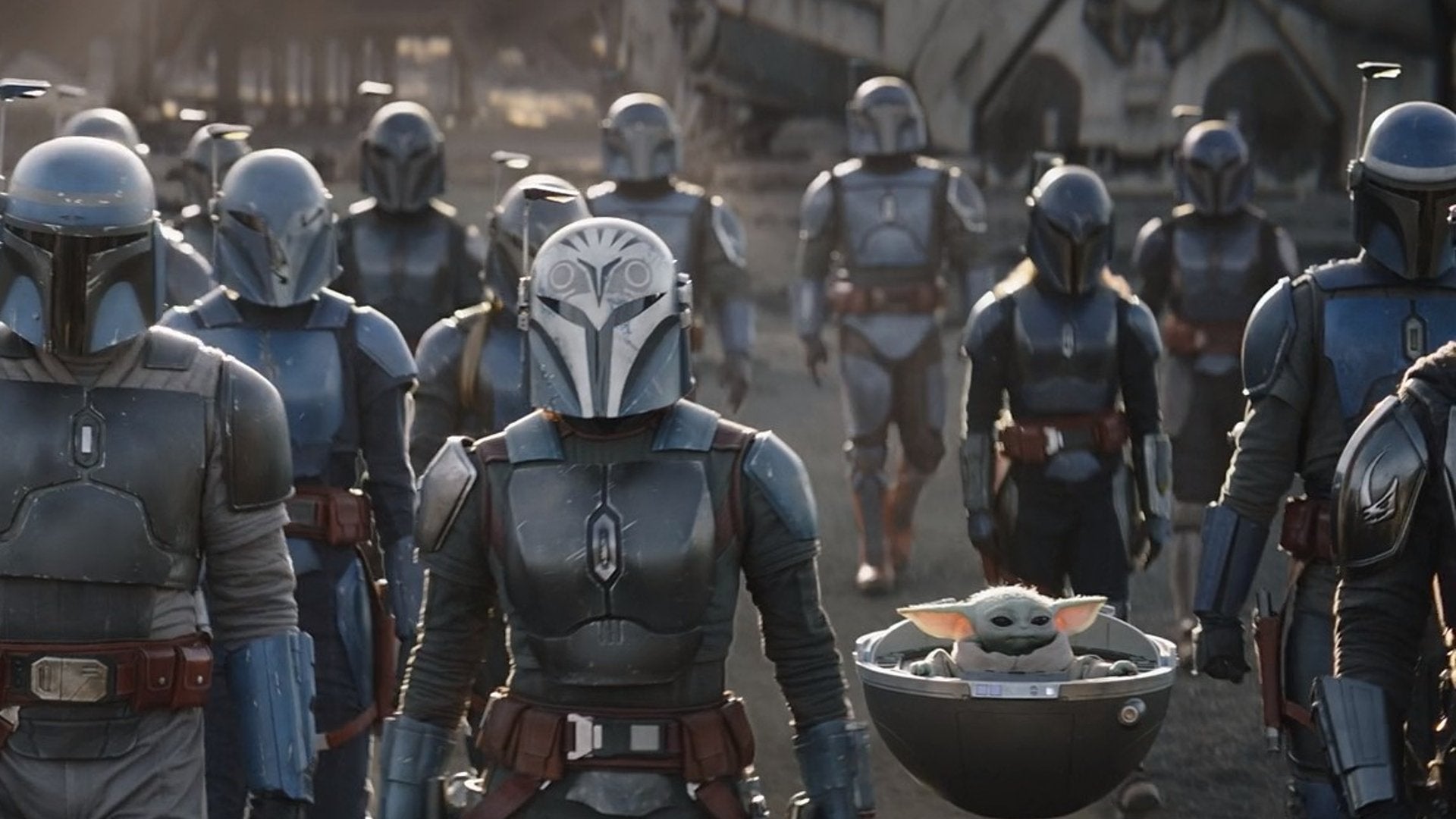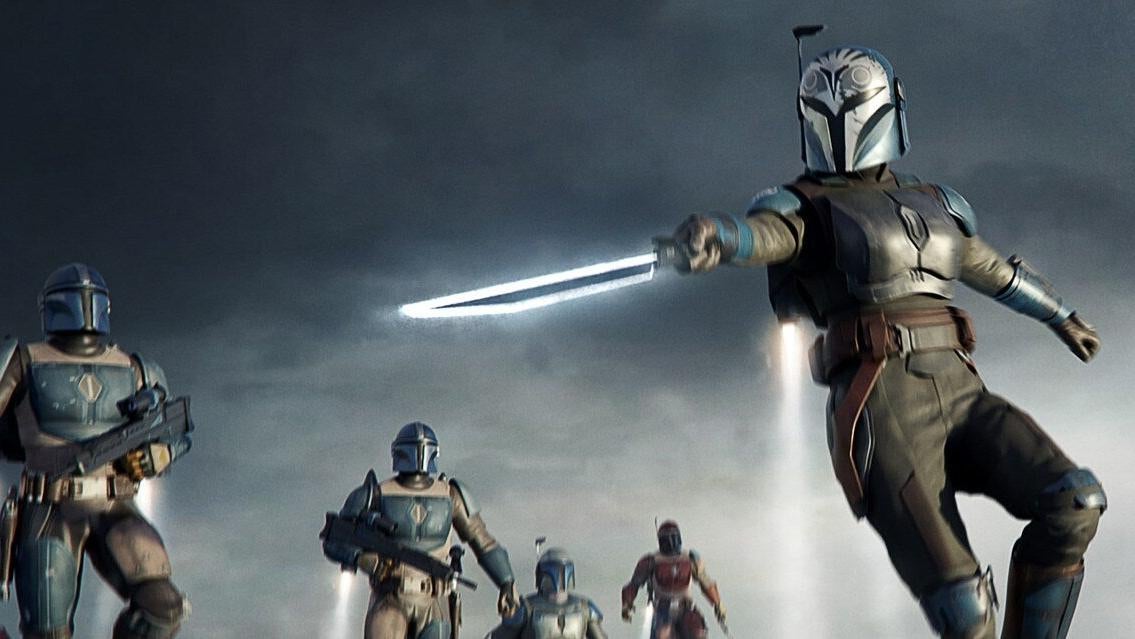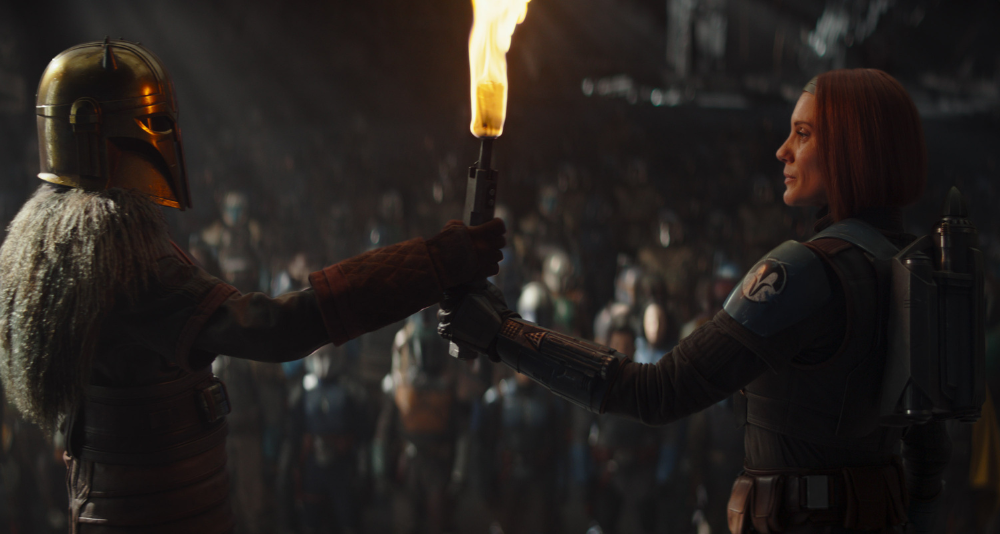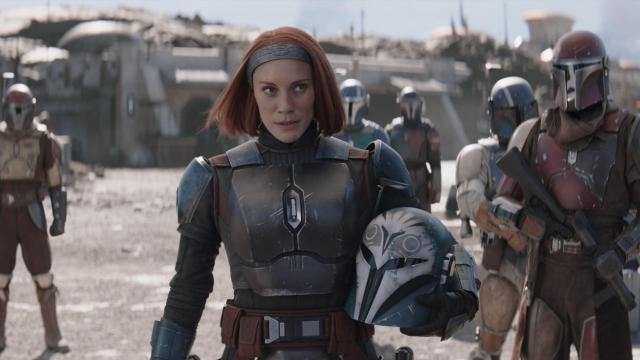Season three of The Mandalorian has finished telling its tale, and boy it’s been a bumpy ride. After the dizzying highs of Andor and the mixed bags of The Book of Boba Fett and Obi-Wan Kenobi, I clicked on the Disney+ app each week with a strange mix of excitement and dread.
“This is it,” I would think. “This is the week things go belly up.”
And yet, they didn’t! With a couple of exceptions (all of the stories around Navarro were kind of a giant snooze-fest; I need to know what the stewards of these shows have against Luke Skywalker and the New Republic), the flagship Star Wars television series kept up the energy of the first two seasons and delivered what I didn’t think was possible: a nuanced, mythic story about the restoration of Mandalore.
That story only holds up because of two supporting characters: returning Clone Wars Jedi frenemy Bo-Katan Kryze, and blacksmith/priest/cult leader the Armorer, the latter of whom has carried the weight of explaining what Mandalorians “are” to casual Star Wars fans since season one. I’ve been surprised to see reactions to this season that derides these two characters. There’s been moaning about how the Armour is just using technicalities to resolve major conflicts, and complaints that Bo-Katan is being “done dirty” or that her character arc is “embarrassing.”
But thanks to a mix of great performances, key camerawork, and a mythic presentation, those arguments couldn’t be further from what the show is diving into: a meditation on how disparate groups of people reconcile their beliefs and work together to build a new home.

What Even Is a Mandalorian?
Mandalorians were first introduced in Star Wars in the films The Empire Strikes Back and Return of the Jedi through the character of Boba Fett, a bounty hunter hired to track down Han Solo and Princess Leia. Boba Fett’s fan-favourite status encouraged other Star Wars creators to dive into stories about Mandalore and Mandalorian culture. Here’s the thing though: if you weren’t a giant nerd in the ‘90s or 2000s, you knew none of that. Boba Fett was just a cool helmet guy with a gun. The word “Mandalorian” wasn’t in your vocabulary. If nothing else the Disney+ show has moved mountains by making this obscure proper noun something that is on the lips of everyday Star Wars fans.
The Mandalorian moved those mountains by kicking off the first live-action Star Wars TV show with a group of Mandalorians completely unrelated to any worldbuilding that had been done in The Clone Wars or any other stories. To fans like me, this was baffling, and almost felt like a retcon! But it gave fresh viewers an easy way to learn what the word “Mandalorian” meant though protagonist Din Djarin and the Armorer. The Armorer is a religious figure who dictates “The Creed” which guides this group of reclusive warriors, and Din Djarin visibly struggles to live by its rules as he takes up a quest to protect Grogu.
It’s pretty impressive worldbuilding, especially when season two took the surprise twist of re-integrating characters and concepts introduced in The Clone Wars. Katee Sackhoff’s return as Bo-Katan Kryze allowed the actor to finish a story that began in the animated show and set her up as a contrasting figure to the Armorer. She wants to lead the Mandalorian people who are now a scattered diaspora, and thinks that a relic called the Darksaber can help her do it. She’s a secular character who wants to make use of a religious symbol and openly scoffs at the practices of Din Djarin’s cult. That hostility is returned in kind by the Armorer in an episode of The Book of Boba Fett in which she refers to her as “a cautionary tale,” and finally explains the events that split the Mandalorian people apart: a genocidal purge conducted by Giancarlo Esposito’s Moff Gideon.
Though Bo-Katan is later blessed as the Mandalorian who “walks both worlds,” it’s the actions of Din Djarin that reconcile these two belief systems. Din’s selfless interest in protecting Grogu leads him on a journey where he has to balance his adherence to the Creed and doing what it takes to defeat a fascist Imperial remnant. By the end of season two, Din Djarin has somehow done the impossible: he’s betrayed the Creed by removing his helmet, and yet now wields the Darksaber, which should make him the leader of all Mandalorians.
Din’s personal story fades into the background of The Mandalorian’s third season, but his simultaneous heresy and anointment sets up an unusual status quo. The fight to reclaim Mandalore isn’t just about power, victory, or defeat, it’s now one that’s religious in nature.

Mandalore’s Reclamation and Echoes of Jewish Culture
There’s no direct symbology linking Mandalorians to any specific Earth culture, but as someone raised in a (very secular) Jewish household, the whole thing seemed really familiar. The Mandalorians are a scattered people cast out of their homeland by a massive Empire, and are now divided into different tribes who begin to take on different cultures. That’s a succinct summary of what I was taught about the culture I grew up in.
That reading might even have some textual backing. Savvy Redditors spotted that an episode of season three called “The Spies” contained a distinct lack of any spycraft. But “The Spies” might be a playful reference to the Twelve Spies from the Old Testament’s Book of Numbers. In that text, the Twelve Spies are a group of Israelite chieftains sent out to scout the land of Canaan as a new home for their people. And in this episode, 12 Mandalorians step up to volunteer for a search party that sets out to reclaim Mandalore, which is a literal promised land for the Mandalorian people. (The total party that steps foot on the planet is 14 when you count Bo-Katan and Grogu.)
That’s the most literal Biblical reference I’ve seen in The Mandalorian but where there aren’t references, there is a very real dramatic force that feels true to how I was raised as a Jewish child: Jewish people are constantly arguing about tradition and adapting those traditions to fit in a changing world. For example, a beloved text in my family was Joseph Stein’s Broadway musical Fiddler on the Roof, which tells the story of a Jewish family in Russia grappling with tradition and violent change.
It’s a play where this kind of conflict is put front and centre. And thanks to Bo-Katan and the Armorer, so does The Mandalorian. If you think of conflict only as a run-up to violence, then season three of The Mandalorian should pit these two leaders directly against each other. Both Bo-Katan and the Armorer, unyielding in their beliefs, should fight over how to reclaim Mandalore as fits their vision for the Mandalorian people.
But for these two, their conflict becomes a means for reconciling the gap between their culture, mostly thanks to area himbo Din Djarin. His blundering back onto the surface of Mandalore sets up a startling realisation for both of his allies: the planet can be reclaimed, and it will take all of the Mandalorian people to do it. These characters come to that realisation in different moments. For Bo-Katan, it feels like this becomes possible when she learns the planet’s surface isn’t a toxic wasteland. For the Armorer, it’s when she hears that Bo-Katan witnessed a Mythosaur — a mythical creature whose return will “herald the beginning of a new era.”
Bo-Katan’s encounter with a Mythosaur in the Sacred Waters (which Din Djarin is unconscious for) is this moment that’s the fuzzy line between the spiritual and the literal. The Mythosaur itself does not seem to be a supernatural creature, just a cavern-dweller that’s avoided civilisation. And there is the rub of so many religious traditions. Religious scholars are often able to determine that with context, seemingly superstitious rules or events can make more literal sense once you learn more about historical context. Faith can often be a kind of projection, and texts that were interpreted one way can now be understood in another.
And if Mythosaurs weren’t seen by Mandalorians because of how large and industrial the world had become… seeing one would literally herald the dawn of a new age. Diving into a subterranean lake and catching a glimpse of your people’s equivalent of the Loch Ness Monster (then claiming it’s a spiritually relevant event) sure seems like a mythical “technicality.” But it’s a revealing event because it highlights how many of the Armorer’s tightly held traditions might just be technicalities themselves.
The Mandalorian’s “Technicalities” Aren’t Technicalities, They’re Reconciliation

Arguments about the Creed in The Mandalorian date all the way back through earlier seasons. Din Djarin is often challenged because of his status as a “foundling” (an orphan adopted into Mandalorian culture). His dotage of Grogu is off-putting because of how Mandalorians view Jedi as their mortal enemies. And the Armorer’s cohort Paz Vizsla demands to know why Din is allowed to keep the Darksaber even though he is “Mandalorian no more.”
The Armorer is the one who weaves all these moments together. At times she is able to interpret Din Djarin’s actions through the context of the Creed, and other times she draws harsh lines. Even though Bo-Katan and fellow Mandalorian resistance fighter Axe Woves call her a zealot, she seems very far from that. She’s a religious leader trying to reconcile teachings that are supposed to have all the answers but aren’t fully adequate to explain the terrible events that have befallen her people. Likewise, Bo-Katan isn’t a would-be warlord who’d do anything for the Darksaber. In season three’s second episode, “The Mines of Mandalore,” there are some pretty deliberate shots showing how the blade falls from Din Djarin’s hands and is reclaimed by Bo-Katan. She eyes him carefully when he reclaims the blade after waking up — but doesn’t try to take it.
The editing in this scene is deliberate. Episode director Rachel Morrison seems intent on making sure the viewer tracks who has “earned” the right to wield the blade — in order to signal to the audience that Bo-Katan is rethinking how to help her people. It’s a great setup for when Din Djarin hands over the blade in episode six, “Guns for Hire.” I understand why people call this a technicality, but it really might sell something more resonant than the weight of a would-be Excalibur: that all traditions are built on technicalities, and it’s the values of the people who believe in them that gives them life. Moff Gideon and other cynical warmongers embraced the tradition of the Darksaber because they valued power. But by the time the third season of The Mandalorian came to a close, Bo-Katan had rejected that mindset — and as a reward, was able to see Mandalore be truly reborn.
This is a character arc that gives dimensionality to ascended background character Bo-Katan. She, the Armorer, and the audience are all given time to reflect on the true meaning of tradition and to ask if conflict needs to end with a clear winner, or if people who share fundamental values can come together to do right by their community.
All three seasons of The Mandalorian are now streaming on Disney+.
